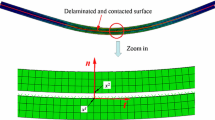An analysis is carried out and a choice between two continual theories of adhesive interactions which can be used for modeling cracks on the contact surface of phases in fibrous composites is made. It is shown that, within the frameworks of the adhesion theories — the Gurtin–Murdoch surface elasticity theory and the Belov–Lurie theory of ideal adhesion — the statements of boundary problems for shear (Mode II) and tear cracks (Mode III) are identical, but for the cracks of normal separation (Mode I), the adhesive properties can be taken into account only in the theory of ideal adhesion.
Similar content being viewed by others
References
V. A. Nelyub and P. A. Belov, “Methods for increasing the resistance of CFRPs to delamination by controlling adhesion between the fiber and matrix,” Nov. Materialoved. Nauka Tekhn., No. 5, 3 (2013).
V. A. Nelyub, “Estimation of the adhesive interaction between carbon fibers and an epoxy binder,” Klei. Germet. Tekhnol., No. 7, 20-22 (2014).
L. P. Kobets, V. A. Nelyub, and P. A. Belov, “Investigation of the paramagnetic absorption of carbon fibers and polymer composites based on them,” in: Actual Problems of Education and Science, Trans. Int. Scient.-Pract. Conf., December 30, 2013, Pt. 14, Tambov (2014), pp. 64-72.
V. A. Nelyub, Yu. M. Mironov, M. O. Makeev, Ya. B. Volkova, and E. A. Zhukova, “Investigation of the degree of disorder of structures of carbon fibers by the method of combinational scattering spectroscopy,” Vse Mater. Entsiklop. Sprav., No. 3, 38-42 (2013).
V. A. Nelyub and I. A. Alexanderov, “Estimation of roughness of the surfaces of carbon fibers by using an atomic-force microscope,” Vse Mater. Entsiklop. Sprav., No. 4, 22-25 (2013).
P. A. Belov, O. V. Zaitsev, L. P. Kobets, and V. A. Nelyub, “Control over the surface adhesion of carbon fiber by means of the time of thermo-oxidation process,” in: Fundamental and Applied Aspects of New Highly Efficient Materials. Trans. All-Russ. Sci. Internet Conf. with Int. Particip., Kazan’ (2013).
V. A. Nelyub, “A method of determination of the adhesive strength of a fiber-matrix system alternative to the pull-out experiment,” in: Actual Problems of Education and Science, Trans. Int. Scient.-Pract. Conf., December 30, 2013, Pt. 14, Tambov (2014), pp. 89-92.
M. E. Gurtin and F. I. Murdoch, “Surface stress in solids,” Int. J. Solid. Struct., 14, 431-440 (1978).
P. A. Belov and S. A. Lurie, “Theory of ideal adhesive interactions,” Mekh. Komposits. Mater. Konstr., No. 4, 519-536 (2007).
P. A. Belov and S. A. Lurie, Mathematical Theory of Defective Media, ISBN 78-3-639-73761-5, Palmarium Academic Publ. (2014).
Acknowledgments
Some results of the present paper have been obtained within the framework of the studies according to the Agreement on granting No. 14.577.21.0023 with the Ministry of Education and Sciences of the Russian Federation. The identifier of applied scientific investigations (of the project) [No.] RFMEFI57714X0023.
Author information
Authors and Affiliations
Corresponding author
Additional information
Translated from Mekhanika Kompozitnykh Materialov, Vol. 51, No. 6, pp. 1061-1068, November-December, 2015.
Rights and permissions
About this article
Cite this article
Belov, P.A., Nelub, V.A. Choice of the Theory of Adhesive Interactions for Modeling Interlayer Cracks in Composites. Mech Compos Mater 51, 745–750 (2016). https://doi.org/10.1007/s11029-016-9545-8
Received:
Published:
Issue Date:
DOI: https://doi.org/10.1007/s11029-016-9545-8




